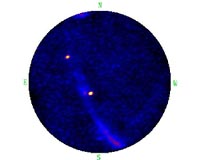 |
West Lafayette IN (SPX) Feb 24, 2010 Researchers have completed work on a crucial component for an experimental hydrogen storage system for cars, part of efforts to reduce pollution and the use of fossil fuels in transportation. The system uses a fine metal powder to absorb hydrogen gas under high pressure. When the powder absorbs hydrogen, it becomes a "metal hydride," and the process is called "hydriding." By then decreasing the pressure in the vessel or warming the metal hydride, the hydrogen can be released to drive a fuel cell or engine. A complication in perfecting the technology, however, is that the hydriding process generates heat, which hinders the absorption process and prevents the hydrogen storage vessel from being filled rapidly, said Issam Mudawar, a Purdue University professor of mechanical engineering who is leading the work with research assistant professor Timothee Pourpoint and doctoral student Milan Visaria. "If you're driving your hydrogen car, you can't wait an hour at the filling station," Mudawar said. "For this system to be practical, you have to be able to cool the hydride efficiently so that the storage vessel can be filled within five minutes with enough fuel to drive 300 miles." The researchers have made progress in solving the problem by designing, building and testing the system's heat exchanger and circulating coolant through tubes to remove heat and speed hydrogen storage, Mudawar said. The engineers filed a final patent in February for the heat exchanger, a coil of stainless steel tubing that fits inside a hydrogen storage "pressure vessel" 4 inches in diameter. Standard automotive coolant is circulated through the tubing. Such a storage technology could help make hydrogen cars a reality if other researchers are successful in developing improved alloys for hydriding and better fuel cells, which generate electricity to power an electric motor. The hydrogen also could be burned instead of gasoline in internal combustion engines. Due to space constraints, it is essential that the heat exchanger occupy the least volume possible inside the storage vessel. Using a theoretical model they developed, the researchers determined how to precisely position the tubing so that no fins are needed to dissipate heat. Eliminating the fins reduces the cost, weight and size of the heat exchanger, Mudawar said. The researchers designed a system that occupies the least space possible while also properly cooling the hydride. Whereas an earlier prototype occupied 30 percent of the vessel, leaving 70 percent for the metal hydride, the new design occupies 7 percent, leaving 93 percent for the hydride. "The idea behind this latest design is to provide the coolant as close as possible to the hydride while eliminating the need for bulky heat spreading components like fins," Mudawar said. "The main advantages of this design are simplicity and flexibility. It can easily be adapted depending on cooling and size requirements." The work was conducted in Purdue's Hydrogen Systems Laboratory at the university's Maurice J. Zucrow Laboratories.
Share This Article With Planet Earth
Related Links Purdue University All About Solar Energy at SolarDaily.com
 LOFAR Maps The Radio Sky At Effelsberg
LOFAR Maps The Radio Sky At EffelsbergEffelsberg, Germany (SPX) Dec 22, 2009 Scientists at the Max Planck Institut for Radio Astronomy have made the first LOFAR "all-sky" images in the 110 to 190 MHz range using LOFAR high-band antennas at the LOFAR station in Effelsberg, Germany. These images are the first high-band, all-sky images made from any complete LOFAR station, and mark a significant milestone in the development of the LOFAR project. ... read more |
|
| The content herein, unless otherwise known to be public domain, are Copyright 1995-2010 - SpaceDaily. AFP and UPI Wire Stories are copyright Agence France-Presse and United Press International. ESA Portal Reports are copyright European Space Agency. All NASA sourced material is public domain. Additional copyrights may apply in whole or part to other bona fide parties. Advertising does not imply endorsement,agreement or approval of any opinions, statements or information provided by SpaceDaily on any Web page published or hosted by SpaceDaily. Privacy Statement |